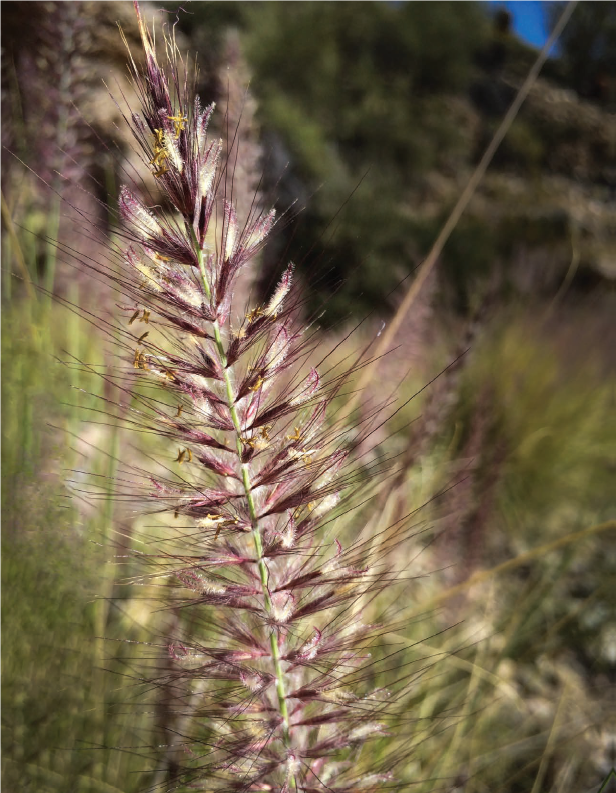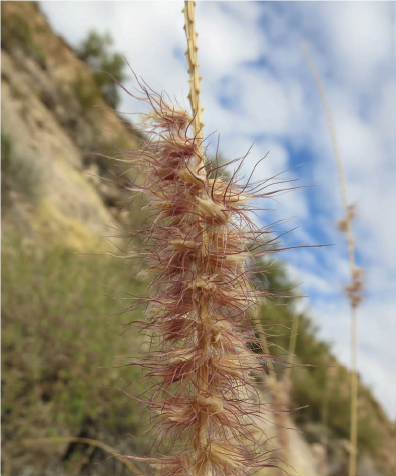Originally published in the Spring 2017 Edition of Mountain Lines
By Dr. Helen Rowe, McDowell Sonoran Conservancy Parsons Field Institute Associate Director
Over half of Scottsdale’s McDowell Sonoran Preserve’s 80-mile boundary is surrounded by urban development, making it easily accessible to incursion from nonnative plants. Recent surveys by the McDowell Sonoran Conservancy Parsons Field Institute show that over 60.5 acres of the Preserve are currently dominated by two invasive kinds of grass—buffelgrass (Pennisetum ciliare) and fountain grass (Pennisetum setaceum). These invasive grasses present two major problems—they increase fire hazard and displace native plants.
Humans brought these grasses to Arizona, along with many other nonnative plants and animals over many decades. Buffelgrass, introduced into the United States in the 1930s as livestock forage, did not initially thrive in the desert. Then in the 1980s, it began to expand rapidly. Fountain grass, introduced into Arizona as an ornamental landscape plant, was well established in the Tucson area by the 1940s.
Buffelgrass is a perennial bunch-grass considered to be a major threat to biodiversity in the southwestern United States and Australia. Buffelgrass is apomictic, meaning it produces seeds without using sexual reproduction. The seeds are dispersed by the wind or dropped to the ground. It also reproduces vegetatively sending rhizomes (lateral shoots) underground and stolons (lateral stems) along the surface. New plants grow from the rhizomes that send grass shoots up to the soil surface, and from the stolons that send their roots below the surface. The preferred habitat of buffelgrass is valleys and low slopes with recently disturbed areas, but it will also grow on steep rocky hillsides. The low water requirements for buffelgrass emergence and its ability to capture more water resources than native plants give buffelgrass a highly competitive advantage in arid environments. Buffelgrass also seems to be able to adapt more rapidly to environmental changes than native species.
Fountain grass in Arizona prefers sandy soils in desert riparian areas and washes but is also found in grasslands, canyons, rocky slopes, roadsides, and disturbed sites. Like buffelgrass, it is an apomictic, wind-dispersed, perennial bunchgrass. However, unlike buffelgrass, fountain grass does not spread vegetatively.
Buffelgrass and fountain grass are highly productive and present a significant fire hazard. Both kinds of grass dramatically increase the fuel load for fire consumption compared to native communities and therefore increase the threat of wildfire. The threat is particularly acute in the Sonoran Desert, where the ecosystem is not fire-adapted. This means that when a desert fire destroys native plants, reestablishment is
slow. Buffelgrass and fountain grass, on the other hand, are fire-adapted, and readily re-establish themselves after a fire. Several studies have clearly documented an increase in their abundance after a fire. The cycle of invasive grass species increasing fire load and frequency change ecosystem conditions in a feedback loop that leads to invasive grass dominance. This loop has been dubbed a grass fire cycle.
Even in the absence of a fire threat, both nonnative species have been shown to displace native species and reduce plant biodiversity where they invade. Thus, native plant communities invaded by buffelgrass demonstrate less native species richness. Buffelgrass has been implicated in the die-off of the native woody species, the yellow palo verde, due to the consumption of shallow water by these bunchgrasses.
As a result of studying the scientific literature, the study group worked together to develop a nonnative species strategic plan for the Preserve and surrounding areas. Strategic plans, a common approach in integrated pest management, help managers prioritize actions given limited resources. The study group reviewed plans from Australia, Tucson, and Texas, and developed a strategy that combined removal of dispersed populations, and monitoring of the grasses; designed a field study to test different removal techniques in the Preserve; and prioritized surveys for the Preserve perimeter and along major roads near the Preserve.
Although there has been substantial research on buffelgrass and fountain grass, the group found no published papers that compared the efficacy of various removal treatments on control-ling the nonnative plants with the treatment effects on native vegetation over a long period. Thus, the group developed an experiment to compare common removal methods in a field study to determine which treatment can best control the invasive species and protect native plant species at the lowest cost. The experimental treatments will be a combination of pulling, mowing, and herbicide repeated annually. We are seeking funding to launch the experiment.
There was one positive finding from the literature search. Given the longevity and robustness of native seeds in the soil, native plant species can dominate post-treatment vegetation after the removal of buffelgrass. Ultimately, the removal treatment results will be integrated into removals elsewhere on the Preserve and region-ally, so that managers and volunteer teams throughout the Valley know the most effective and relevant integrated weed management approaches.
The Parsons Field Institute continues the daunting effort of nonnative grass removal because the Preserve is one of the most biologically diverse open-space areas in the Phoenix Valley. It hosts over 378 species of plants, 200 species of vertebrate animals, and countless invertebrates. The Preserve is also home to six species of animals listed as Species of Concern by the U.S. Fish and Wildlife Service. Those riches alone make the Preserve worth conserving. When you also add on the magnificent views and the trails for hiking, biking, and horseback riding, you have a remarkable place where it is justifiable to line up the volunteers and take a stand against the invaders. This work will greatly improve our capacity to protect this sensitive Sonoran Desert habitat for the long term.



